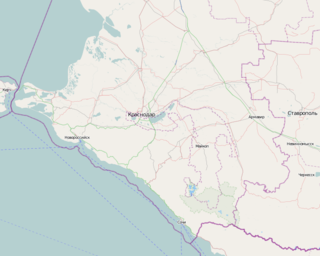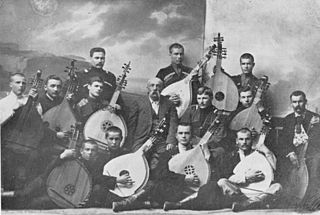 W
WKuban is a geographic region of Southern Russia surrounding the Kuban River, on the Black Sea between the Don Steppe, the Volga Delta and the Caucasus, and separated from the Crimean Peninsula to the west by the Kerch Strait. Krasnodar Krai is often referred to as "Kuban", both officially and unofficially, although the term is not exclusive to the krai and accommodates the republics of Adygea, Karachay-Cherkessia, and parts of Stavropol Krai.
 W
WAlexei Ivanovich Avtonomov (1890–1919) was a Russian Red Army military commander during the Russian Civil War.
 W
WNikolai Alekseevich Boguslavsky (1850–1933) was an organiser and sponsor of the kobzar renaissance in the Kuban, a community leader, publisher. Bohuslavsky organized the first (1913) and second (1916) schools of kobzar art in the Kuban. Under his support bandura playing in the Kuban became a popular movement.
 W
WThe flag of Kuban is a horizontal tricolour of blue, purple, and green. The purple band is twice the width of the other two. The flag was adopted by Kuban Parliament on 10 February 1919 as the national and state flag of the Kuban People's Republic. The colours symbolise unity of three principal social-ethnic groups of Kuban society: majority - Cossacks /purple/, autochthonous - Circassians (Adyghe) /green/, and minority - all others /blue/.
 W
WKrasnodar Krai is a federal subject of Russia, located in the North Caucasus region in Southern Russia and administratively a part of the Southern Federal District. Its administrative center is the city of Krasnodar. The third most-populous federal subject, the krai had a population of 5,226,647 as of the 2010 Census.
 W
WThe Kuban is a river in the Northwest Caucasus region of European Russia. It flows mostly through Krasnodar Krai for 660 kilometres (410 mi) but also in the Karachay–Cherkess Republic, Stavropol Krai and the Republic of Adygea.
 W
WThe Kuban Bridgehead, also known as the "Goth's head position" , was a German position on the Taman Peninsula, Russia, between the Sea of Azov and the Black Sea. Existing from January to October 1943, the bridgehead formed after the Germans were pushed out of the Caucasus. The heavily fortified position was intended as a staging area for the Wehrmacht which was to be used to renew attacks towards the oil wells of the Caucasus. The bridgehead was abandoned when the Red Army breached the Panther–Wotan line, forcing an evacuation of the German forces across the Kerch Strait to Crimea.
 W
WKuban Cossack Chorus is one of the leading Folkloric ensembles in Russia. Its repertoire and performances reflect the songs, dances and folklore of the Kuban Cossacks.
 W
WKuban Cossacks, or Kubanians, are Cossacks who live in the Kuban region of Russia. Most of the Kuban Cossacks are descendants of different major groups of Cossacks who were re-settled to the western Northern Caucasus in the late 18th century. The western part of the host was settled by the Black Sea Cossack Host who were originally the Zaporozhian Cossacks of Ukraine, from 1792. The eastern and southeastern part of the host was previously administered by the Khopyour and Kuban regiments of the Caucasus Line Cossack Host and Don Cossacks, who were re-settled from the Don from 1777.
 W
WThe Kuban Nogai Uprising of 1783 was the last significant attempt of the Nogai steppe nomads to resist the expansion of Russia. Its defeat opened the way for Slavic colonization of the lands north of the Caucasus and was an early step in the Russian conquest of the Caucasus. It resulted from the Annexation of Crimea by the Russian Empire and tsarist plans to resettle the Nogais to the Urals. It was brutally suppressed in a few months by the troops under the command of Alexander Suvorov.